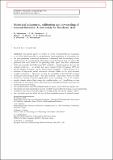Por favor, use este identificador para citar o enlazar a este item:
http://hdl.handle.net/10261/222007COMPARTIR / EXPORTAR:
 SHARE SHARE
 CORE
BASE CORE
BASE
|
|
| Visualizar otros formatos: MARC | Dublin Core | RDF | ORE | MODS | METS | DIDL | DATACITE | |

| Campo DC | Valor | Lengua/Idioma |
|---|---|---|
| dc.contributor.author | Manzanas, Rodrigo | es_ES |
| dc.contributor.author | Gutiérrez, José M. | es_ES |
| dc.contributor.author | Bhend, Jonas | es_ES |
| dc.contributor.author | Hemri, Stephan | es_ES |
| dc.contributor.author | Doblas-Reyes, Francisco J. | es_ES |
| dc.contributor.author | Penabad, E. | es_ES |
| dc.contributor.author | Brookshaw, Anca | es_ES |
| dc.date.accessioned | 2020-10-29T12:00:45Z | - |
| dc.date.available | 2020-10-29T12:00:45Z | - |
| dc.date.issued | 2020 | - |
| dc.identifier.citation | Climate Dynamics 54: 2869–2882 (2020) | es_ES |
| dc.identifier.issn | 0930-7575 | - |
| dc.identifier.uri | http://hdl.handle.net/10261/222007 | - |
| dc.description.abstract | The present paper is a follow-on of the work presented in Manzanas et al. (Clim Dyn 53(3–4):1287–1305, 2019) which provides a comprehensive intercomparison of alternatives for the post-processing (statistical adjustment, calibration and downscaling) of seasonal forecasts for a particularly interesting region, Southeast Asia. To answer the questions that were raised in the preceding work, apart from Bias Adjustment (BA) and ensemble Re-Calibration (RC) methods—which transform directly the variable of interest,—we include here more complex Perfect Prognosis (PP) and Model Outputs Statistics (MOS) downscaling techniques—which operate on a selection of large-scale model circulation variables linked to the local observed variable of interest. Moreover, we test the suitability of BA and PP methods for the post-processing of daily—not only seasonal—time-series, which are often needed in a variety of sectoral applications (crop, hydrology, etc.) or to compute specific climate indices (heat waves, fire weather index, etc.). In addition, we also undertake an assessment of the effect that observational uncertainty may have for statistical post-processing. Our results indicate that PP methods (and to a lesser extent MOS) are highly case-dependent and their application must be carefully analyzed for the region/season/application of interest, since they can either improve or degrade the raw model outputs. Therefore, for those cases for which the use of these methods cannot be carefully tested by experts, our overall recommendation would be the use of BA methods, which seem to be a safe, easy to implement alternative that provide competitive results in most situations. Nevertheless, all methods (including BA ones) seem to be sensitive to observational uncertainty, especially regarding the reproduction of extremes and spells. For MOS and PP methods, this issue can even lead to important regional differences in interannual skill. The lessons learnt from this work can substantially benefit a wide range of end-users in different socio-economic sectors, and can also have important implications for the development of high-quality climate services. | es_ES |
| dc.description.sponsorship | This work has been funded by the C3S activity on Evaluation and Quality Control for seasonal forecasts and the EU project AfriCultuReS (H2020-EU.3.5.5, GA 774652). JMG was partially supported by the Project MULTI-SDM (CGL2015-66583-R, MINECO/FEDER). FJDR was partially funded by the H2020 EUCP project (GA 776613). | es_ES |
| dc.language.iso | eng | es_ES |
| dc.publisher | Springer Nature | es_ES |
| dc.relation | info:eu-repo/grantAgreement/EC/H2020/776613 | es_ES |
| dc.relation | info:eu-repo/grantAgreement/EC/H2020/774652 | es_ES |
| dc.relation | info:eu-repo/grantAgreement/MINECO/Plan Estatal de Investigación Científica y Técnica y de Innovación 2013-2016/CGL2015-66583-R | es_ES |
| dc.relation.isversionof | Postprint | es_ES |
| dc.rights | openAccess | en_EN |
| dc.title | Statistical adjustment, calibration and downscaling of seasonal forecasts: a case-study for Southeast Asia | es_ES |
| dc.type | artículo | es_ES |
| dc.identifier.doi | 10.1007/s00382-020-05145-1 | - |
| dc.description.peerreviewed | Peer reviewed | es_ES |
| dc.relation.publisherversion | https://doi.org/10.1007/s00382-020-05145-1 | es_ES |
| dc.identifier.e-issn | 1432-0894 | - |
| dc.embargo.terms | 2021-02-05 | es_ES |
| dc.contributor.funder | European Commission | es_ES |
| dc.contributor.funder | Ministerio de Economía y Competitividad (España) | es_ES |
| dc.relation.csic | Sí | es_ES |
| oprm.item.hasRevision | no ko 0 false | * |
| dc.identifier.funder | http://dx.doi.org/10.13039/501100003329 | es_ES |
| dc.identifier.funder | http://dx.doi.org/10.13039/501100000780 | es_ES |
| dc.type.coar | http://purl.org/coar/resource_type/c_6501 | es_ES |
| item.cerifentitytype | Publications | - |
| item.languageiso639-1 | en | - |
| item.openairecristype | http://purl.org/coar/resource_type/c_18cf | - |
| item.grantfulltext | open | - |
| item.fulltext | With Fulltext | - |
| item.openairetype | artículo | - |
| Aparece en las colecciones: | (IFCA) Artículos | |
Ficheros en este ítem:
| Fichero | Descripción | Tamaño | Formato | |
|---|---|---|---|---|
| staticalAsia.pdf | 19,58 MB | Adobe PDF |  Visualizar/Abrir |
CORE Recommender
SCOPUSTM
Citations
9
checked on 14-may-2024
WEB OF SCIENCETM
Citations
8
checked on 22-feb-2024
Page view(s)
119
checked on 16-may-2024
Download(s)
529
checked on 16-may-2024
Google ScholarTM
Check
Altmetric
Altmetric
NOTA: Los ítems de Digital.CSIC están protegidos por copyright, con todos los derechos reservados, a menos que se indique lo contrario.
